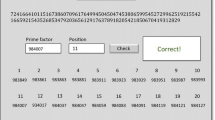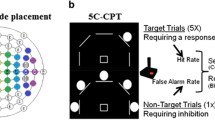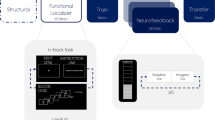Abstract
One important executive function known to be compromised in autism spectrum disorder (ASD) is related to response error monitoring and post-error response correction. Several reports indicate that children with ASD show reduced error processing and deficient behavioral correction after an error is committed. Error sensitivity can be readily examined by measuring event-related potentials (ERP) associated with responses to errors, the fronto-central error-related negativity (ERN), and the error-related positivity (Pe). The goal of our study was to investigate whether reaction time (RT), error rate, post-error RT change, ERN, and Pe will show positive changes following 12-week long slow frequency repetitive TMS (rTMS) over dorsolateral prefrontal cortex (DLPFC) in high functioning children with ASD. We hypothesized that 12 sessions of 1 Hz rTMS bilaterally applied over the DLPFC will result in improvements reflected in both behavioral and ERP measures. Participants were randomly assigned to either active rTMS treatment or wait-list (WTL) groups. Baseline and post-TMS/or WTL EEG was collected using 128 channel EEG system. The task involved the recognition of a specific illusory shape, in this case a square or triangle, created by three or four inducer disks. ERN in TMS treatment group became significantly more negative. The number of omission errors decreased post-TMS. The RT did not change, but post-error RT became slower. There were no changes in RT, error rate, post-error RT slowing, nor in ERN/Pe measures in the wait-list group. Our results show significant post-TMS differences in the response-locked ERP such as ERN, as well as behavioral response monitoring measures indicative of improved error monitoring and correction function. The ERN and Pe, along with behavioral performance measures, can be used as functional outcome measures to assess the effectiveness of neuromodulation (e.g., rTMS) in children with autism and thus may have important practical implications.






Similar content being viewed by others
References
American Psychiatric Association. (2000). Diagnostic and statistical manual of mental disorders (DSM-IVTR) (4th ed.). Washington, D.C.: Text revised.
Arbel, Y., & Donchin, E. (2009). Parsing the componential structure of post-error ERPs: A principal component analysis of ERPs following errors. Psychophysiology, 46, 1288–1298.
Arbel, Y., & Donchin, E. (2011). When a child errs: The ERN and the Pe complex. Psychophysiology, 48, 55–63.
Baruth, J., Casanova, M., El-Baz, A., Horrell, T., Mathai, G., Sears, L., et al. (2010a). Low-frequency repetitive transcranial magnetic stimulation modulates evoked-gamma frequency oscillations in autism spectrum disorders. Journal of Neurotherapy, 14(3), 179–194.
Baruth, J., Casanova, M., Sears, L., & Sokhadze, E. (2010b). Early-stage visual processing abnormalities in high-functioning autism spectrum disorder (ASD). Translational Neuroscience, 1(2), 177–187.
Baruth, J., Sokhadze, E., El-Baz, A., Mathai, G., Sears, L., & Casanova, M. F. (2010c). Transcaranial magentic stimulation as a treatment for autism. In K. Siri & T. Lyons (Eds.), Cutting edge therapies for autism (pp. 388–397). New York: Skyhorse Publishing.
Baruth, J., Williams, E., Sokhadze, E., El-Baz, A., Sears, L., & Casanova, M. F. (2011). Repetitive transcarnial stimulation (rTMS) improves electroencephalographic and behavioral outcome measures in autism spectrum disorders (ASD). Autism Science Digest, 1, 52–57.
Bishop, D. V. (1993). Annotation: autism, executive functions and theory of mind: A neuropsychological perspective. Journal of Child Psychology and Psychiatry, 34, 279–293.
Bogte, H., Flamma, B., van der Meere, J., & van Engeland, H. (2007). Post-error adaptation in adults with high functioning autism. Neuropsychologia, 45, 1707–1714.
Bush, G., Luu, P., & Posner, M. (2000). Cognitive and emotional influences in the anterior cingulate cortex. Trends in Cognitive Science, 4, 214–222.
Carter, C. S., Braver, T. S., Barch, D. M., Botvinick, M. M., Noll, D., & Cohen, J. D. (1998). Anterior cingulate cortex, error detection, and the online monitoring of performance. Science, 280, 747–749.
Casanova, M. F. (2005). Minicolumnar pathology in autism. In M. F. Casanova (Ed.), Recent developments in autism research (pp. 133–144). New York: Nova Biomedical Books.
Casanova, M. F. (2007). The neuropathology of autism. Brain Pathology, 17, 422–433.
Casanova, M. F., Buxhoeveden, D. P., & Brown, C. (2002a). Clinical and macroscopic correlates of minicolumnar pathology in autism. Journal of Child Neurology, 17, 692–695.
Casanova, M. F., Buxhoeveden, D., & Gomez, J. (2003). Disruption in the inhibitory architecture of the cell minicolumn: Implications for autism. The Neuroscientist, 9, 496–507.
Casanova, M. F., Buxhoeveden, D. P., Switala, A. E., & Roy, E. (2002b). Minicolumnar pathology in autism. Neurology, 58, 428–432.
Casanova, M. F., van Kooten, I., Switala, A. E., van England, H., Heinsen, H., Steinbuch, H. W. M., et al. (2006a). Abnormalities of cortical minicolumnar organization in the prefrontal lobes of autistic patients. Clinical Neuroscience Research, 6(3–4), 127–133.
Casanova, M. F., van Kooten, I., van Engeland, H., Heinsen, H., Steinbursch, H. W. M., Hof, P. R., et al. (2006b). Minicolumnar abnormalities in autism II. Neuronal size and number. Acta Neuropathologica, 112(3), 287–303.
Clemans, Z., Sokhadze, T., & El-Baz, A. (2011a). Custom program for extraction of event-related potential peaks in attention tasks. Presented at Research Louisville, Louisville, KY.
Clemans, Z., Sokhadze, E., & El-Baz, A.S. (2011b) A custom-made Matlab program for ERP feature detection in psychological and physiological disorders using wavelet. Presented at the 97th Annual Meeting of Kentucky Academy of Science. Murray, KY.
Daskalakis, Z. J., Christensen, B. K., Fitzgerald, P. B., & Chen, R. (2002). Transcranial magnetic stimulation: A new investigational and treatment tool in psychiatry. Journal of Neuropsychiatry Clinical Neurosciences, 14, 406–415.
Eriksen, B. A., & Eriksen, C. W. (1974). Effects of noise letters on the identification of a target letter in a nonsearch task. Perception & Psychophysics, 16, 143–149.
Falkenstein, M., Hoormann, J., Christ, S., & Hohnsbein, J. (2000). ERP components on reaction errors and their functional significance: A tutorial. Biological Psychology, 51, 87–107.
Franken, I. H., van Strien, J. W., Franzek, E. J., & van de Wetering, B. J. (2007). Error-processing deficits in patients with cocaine dependence. Biological Psychology, 75, 45–51.
Garvey, M. A., & Mall, V. (2008). Transcranial magnetic stimulation in children. Clinical Neurophysiology, 119, 973–984.
Gehring, W. J., Goss, B., Coles, M. G. H., Meyer, D. E., & Donchin, E. (1993). A neural system for error detection and compensation. Psycholological Science, 4, 385–390.
Gehring, W. J., & Knight, R. T. (2000). Prefrontal-cingulate interactions in action monitoring. Nature Neuroscience, 3, 516–520.
George, M. S., Lisanby, S. H., & Sackeim, H. A. (1999). Transcranial magnetic stimulation: applications in neuropsychiatry. Archives of General Psychiatry, 56, 300–331.
George, M. S., Nahas, J., Kozol, F. A., Li, X., Yamanaka, K., Mishory, A., et al. (2003). Mechanisms and the current state of transcranial magnetic stimulation. CNS Spectrum, 8(7), 496–514.
Gershon, A. A., Dannon, P. N., & Grunhaus, L. (2003). Transcranial magnetic stimulation in the treatment of depression. American Journal of Psychiatry, 160, 835–845.
Gillberg, C., & Billstedt, E. (2000). Autism and Asperger syndrome: Coexistence with other clinical disorders. Acta Psychiatrica Scandinavica, 102, 321–330.
Greenberg, B. D. (2007). Transcranial magnetic stimulation in anxiety disorders. In M. S. George & R. H. Belmaker (Eds.), Transcranial magnetic stimulation in clinical psychiatry (pp. 165–178). Washington, DC: American Psychiatric Publishing, Inc.
Helmich, R. C., Siebner, H. R., Bakker, M., Munchau, A., & Bloem, B. R. (2006). Repetitive transcranial magnetic stimulation to improve mood and motor function in Parkinson’s disease. Journal of Neurological Sciences, 248, 84–96.
Henderson, H., Schwartz, C., Mundy, P., Burnette, C., Sutton, S., Zahka, N., et al. (2006). Response monitoring, the error-related negativity, and differences in social behavior in autism. Brain and Cognition, 61, 96–109.
Herrmann, M. J., Remmler, J., Ehlis, A. C., Heindrich, A., & Fallgatter, A. J. (2004). Source localization of the error-related-negativity (ERN/Ne) and positivity (Pe). Cognitive Brain Research, 20, 294–299.
Hewig, J., Coles, M. G. H., Trippe, R. H., Hecht, H., & Miltner, W. H. R. (2011). Dissociation of Pe and ERN/Ne in the conscious recognition of an error. Psychophysiology, 48, 1390–1396.
Hill, E. L. (2004). Evaluating the theory of executive dysfunction in autism. Developmental Review, 24, 189–233.
Hoffman, R. E., & Cavus, I. (2002). Slow transcranial magnetic stimulation, long-term depotentiation, and brain hyperexcitability disorders. American Journal of Psychiatry, 159, 1093–1102.
Holtzheimer, P. E., Russo, J., & Avery, D. H. (2001). A meta-analysis of repetitive transcranial magnetic stimulation in the treatment of depression. Psychopharmacology Bulletin, 35, 149–169.
Just, M. A., Cherkassky, V., Keller, T. A., & Minshew, N. J. (2004). Cortical activation and synchronization during sequence comprehension in high-functioning autism: Evidence of underconnectivity. Brain, 127, 1811–1821.
Kanizsa, G. (1976). Subjective contours. Scientific American, 235, 48–52.
LeCouteur, A., Lord, C., & Rutter, M. (2003). The autism diagnostic interview—revised (ADI-R). Los Angeles, CA: Western Psychological Services.
Loo, C., & Mitchell, P. (2005). A review of the efficacy of transcranial magnetic stimulation (TMS) treatment for depression, and current and future strategies to optimize efficacy. Journal of Affective Disorders, 88, 255–267.
Luu, P., Flaisch, T., & Tucker, D. M. (2000). Medial frontal cortex in action monitoring. Journal of Neuroscience, 20, 464–469.
Luu, P., Tucker, D. M., Derryberry, D., Reed, M., & Poulsen, C. (2003). Electrophysiological responses to errors and feedback in the process of action regulation. Psychological Science, 14, 47–53.
Luu, P., Tucker, D. M. L., Englander, R., Lockfeld, A., Lutsep, H., & Oken, B. (2001). Localizing acute stroke-related EEC changes: Assessing the effects of spatial undersampling. Journal of Clinical Neurophysiology, 18, 302–317.
Maeda, F., Keenan, J. P., Tormos, J. M., Topka, H., & Pascual-Leone, A. (2000). Modulation of corticospinal excitability by repetitive transcranial magnetic stimulation. Clinical Neurophysiolgy, 111, 800–805.
Mars, R. B., Coles, M. G. H., Grol, M. J., Holroyd, C. B., Nieuwenhuis, S., Hulstijn, W., et al. (2005). Neural dynamics of error processing in medial frontal cortex. NeuroImage, 28, 1007–1013.
Mathalon, D. H., Whitfield, S. L., & Ford, J. M. (2003). Anatomy of an error: ERP and fMRI. Biological Psychology, 64, 119–141.
Mountcastle, V. B. (2003). Introduction. Computation in cortical columns. Cerebral Cortex, 13, 2–4.
Mundy, P. (2003). The neural basis of social impairments in autism: The role of the dorsal medial-frontal cortex and anterior cingulate system. Journal of Child Psychology and Psychiatry, 44(793–809), 003.
Mundy, P., & Neal, R. (2001). Neural plasticity, joint attention and a transactional social-orienting model of autism. International Review of Mental Retardation, 23, 139–168.
Murphy, K. R., & Myors, B. (2003). Statistical power analysis: A simple and general model for traditional and modern hypothesis tests (2nd ed.). New York, NY: Lawrence Erlbaum Associates.
Nieuwenhuis, S., Ridderinkhof, K. R., Blom, J., Band, G. P., & Kok, A. (2001). Error-related brain potentials are differentially related to awareness of response errors: evidence from an antisaccade task. Psychophysiology, 38, 752–760.
Oldfield, R. C. (1971). The assessment and analysis of handedness: The Edinburgh inventory. Neuropsychologia, 9, 97–113.
Overbeek, T. J. M., Nieuwenhuis, S., & Ridderinkhof, K. R. (2005). Dissociable components of error processing. Journal of Psychophysiology, 19, 319–329.
Ozonoff, S. (1997). Casual mechanisms of autism: Unifying perspectives from an information-processing framework. In D. J. Cohen & F. R. Volkmar (Eds.), Handbook of autism and pervasive developmental disorders (pp. 868–879). New York: Wiley.
Quintana, H. (2005). Transcranial magnetic stimulation in persons younger than the age of 18. The Journal of ECT, 21, 88–95.
Ridderinkhof, K. R., Ullsperger, M., Crone, E. A., & Nieuwenhuis, S. (2004). The role of the medial frontal cortex in cognitive control. Science, 306, 443–447.
Rippon, G., Brock, J., Brown, C., & Boucher, J. (2007). Disordered connectivity in the autistic brain: Challenges for the ‘new psychophysiology’. International Journal of Psychophysiology, 63, 164–172.
Rosenberg, P. B., Mehndiratta, R. B., Mehndiratta, Y. P., Wamer, A., Rosse, R. B., & Balish, M. (2002). Repetitive magnetic stimulation treatment of comorbid posttraumatic stress disorder and major depression. Journal of Neuropsychiatry and Clinical Neurosciences, 14, 270–276.
Rubenstein, J. L. R., & Merzenich, M. M. (2003). Model of autism: increased ratio of excitation/inhibition in key neural systems. Genes, Brain, and Behavior, 2, 255–267.
Russell, J. (1997). How executive disorders can bring about an inadequate theory of mind. In J. Russell (Ed.), Autism as an executive disorder (pp. 256–304). Oxford, UK: Oxford University Press.
Russell, J., & Jarrold, C. (1998). Error-correction problems in autism: Evidence for a monitoring impairment? Journal of Autism Developmental Disorders, 28, 177–188.
Sokhadze, E., Baruth, J., El-Baz, A., Horrell, T., Sokhadze, G., Carroll, T., et al. (2010a). Impaired error monitoring and correction function in autism. Journal of Neurotherapy, 14, 79–95.
Sokhadze, E., Baruth, J., Tasman, A., El-Baz, A., Mansoor, M., Ramaswamy, R., et al. (2010b). Low-frequency repetitive transcranial magnetic stimulation (rTMS) affects event-related potential measures of novelty processing in autism. Applied Psychophysiology and Biofeedback, 35, 147–161.
Sokhadze, E., El-Baz, A., Baruth, J., Mathai, G., Sears, L., & Casanova, M. (2009a). Effect of a low-frequency repetitive transcranial magnetic stimulation (rTMS) on induced gamma frequency oscillations and event-related potentials during processing of illusory figures in autism spectrum disorders. Journal of Autism and Developmental Disorders, 39, 619–634.
Sokhadze, E., Tasman, A., El-Baz, A., Baruth, J., Mathai, G., Sears, L., et al. (2009b). Event-related study of novelty processing abnormalities in autism. Applied Psychophysiology and Biofeedback, 34, 37–51.
Srinivasan, R., Tucker, D. M., & Murias, M. (1998). Estimating the spatial Nyquist of the human EEC. Behavior Research Methods, Instruments, and Computers, 30, 8–19.
Taylor, S. F., Stern, E. R., & Gehring, W. J. (2007). Neural systems for error monitoring: recent findings and theoretical perspectives. Neuroscientist, 13, 160–172.
Thakkar, K. N., Polli, F. E., Joseph, R. M., Tuch, D. S., Hadjikhani, N., Barton, J. J., et al. (2008). Response monitoring, repetitive behaviour and anterior cingulate abnormalities in autism spectrum disorders (ASD). Brain, 131, 2464–2478.
Van Veen, V., & Carter, C. S. (2002). The timing of action-monitoring process in the anterior cingulate cortex. Journal Cognitive Neuroscience, 14(4), 593–602.
Vlamings, P. H., Jonkman, L. M., Hoeksma, M. R., van Engeland, H., & Kemner, C. (2008). Reduced error monitoring in children with autism spectrum disorder: An ERP study. European Journal of Neurosciences, 28, 399–406.
Wagner, T., Rushmore, J., Eden, U., & Valero-Cabre, A. (2009). Biophysical foundations underlying TMS: Setting the stage for an effective use of neurostimulation in the cognitive neurosciences. Cortex, 45, 1025–1034.
Wassermann, E. M., & Lisanby, S. H. (2001). Therapeutic application of repetitive transcranial magnetic stimulation: A review. Clinical Neurophysiology, 112, 1367–1377.
Wechsler, D. (2003). Wechsler intelligence scale for children (4th ed.). San Antonio, TX: Harcourt Assessment, Inc.
Wechsler, D. (2004). Wechsler abbreviated scale for intelligence. San Antonio, TX: Harcourt Assessment, Inc.
Yeung, N., Cohen, J. D., & Botvinick, M. M. (2004). The neural basis of error detection: Conflict monitoring and the error-related negativity. Psychological Review, 111, 931–959.
Acknowledgments
Funding for this work was provided by the National Institutes for Health grant R01 MH86784 to Manuel Casanova.
Author information
Authors and Affiliations
Corresponding author
Rights and permissions
About this article
Cite this article
Sokhadze, E.M., Baruth, J.M., Sears, L. et al. Prefrontal Neuromodulation Using rTMS Improves Error Monitoring and Correction Function in Autism. Appl Psychophysiol Biofeedback 37, 91–102 (2012). https://doi.org/10.1007/s10484-012-9182-5
Published:
Issue Date:
DOI: https://doi.org/10.1007/s10484-012-9182-5




